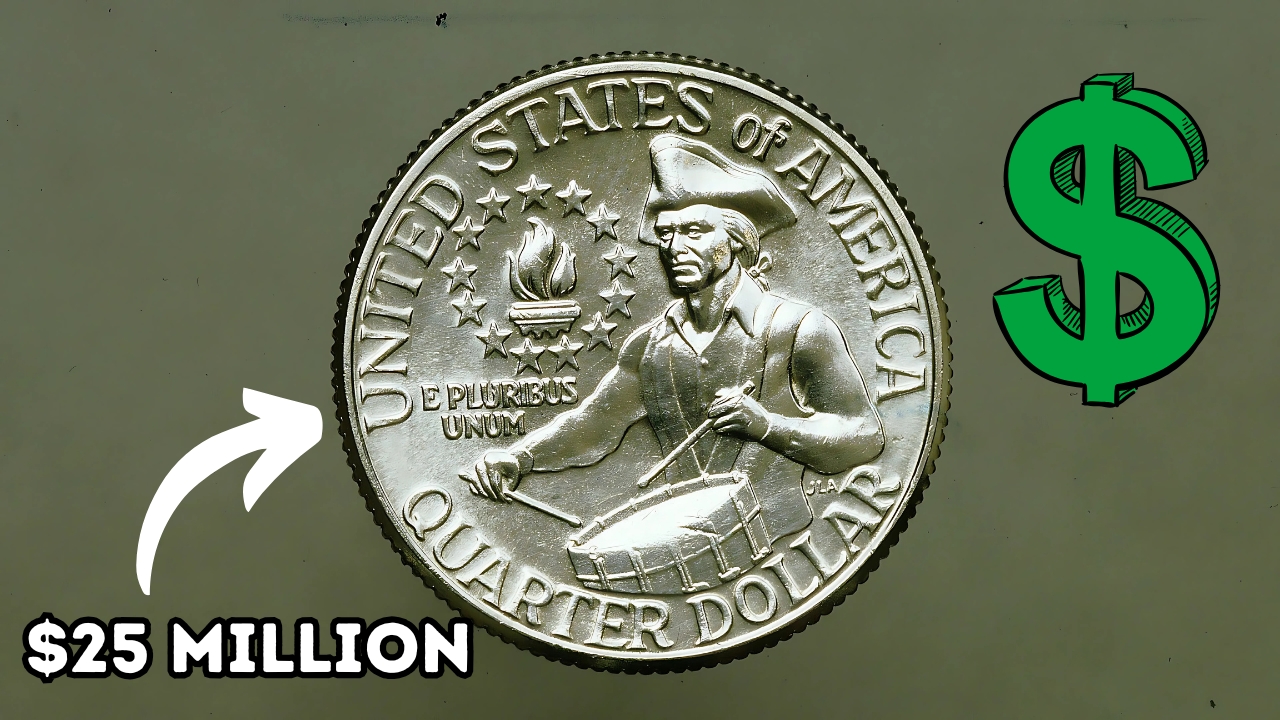Rare Bicentennial Quarter : Among the loose change cluttering your drawers, coin jars, or even your pocket, there might be a gem from the world of numismatics waiting to be discovered—a remarkable variety of Bicentennial quarter that could potentially be worth a staggering $25 million.
This isn’t just a sensational claim; it’s a genuine valuation for an extremely rare minting error that continues to baffle collectors, possibly circulating unnoticed in everyday transactions throughout the United States.
The United States Mint produced Bicentennial quarters from 1975 to 1976 to celebrate the 200th anniversary of America’s independence.
These unique coins featured an image of a colonial drummer on the reverse and celebrated dual dates (1776-1976) on the obverse.
With over 1.7 billion of these commemorative quarters minted, they remain relatively common in circulation today.
However, among these billions exists a remarkably rare variant—so rare that experts believe only a handful exist, with just one confirmed example recognized by the numismatic community.
The $25 Million Error: What Makes It Special
This exceptionally valuable quarter resulted from what experts refer to as a “double-die obverse” error combined with an overdate error unique to the Bicentennial design.
In simpler terms, during the manufacturing process, the die used for striking the coin was accidentally applied twice at slightly different angles, resulting in a subtle doubling effect, particularly noticeable around Washington’s profile and the date and lettering.
What elevates this error coin’s value dramatically compared to other double-die quarters is its unique combination of attributes:
-
The error is specific to the Bicentennial design
-
The doubling is most evident on the dual dates (1776-1976)
-
It was struck on a copper-nickel planchet instead of silver
-
It originated from the Philadelphia Mint (which has no mint mark)
Lawrence Shepherd, a noted numismatic expert, describes it as “the perfect storm of error coin circumstances.”
“You have a historically significant commemorative design paired with a major minting error that somehow slipped through quality control during a surge in public interest in coin collecting.”
Rare Bicentennial Quarter Verification Challenges and Authentication
The immense value attributed to this specific error presents considerable challenges for authentication.
Many collectors have claimed to possess this rare quarter, but almost all examples submitted for professional authentication have turned out to be either altered coins or cases of machine doubling—an anomaly that may look similar but differs significantly from a genuine double-die error.
Both the Professional Coin Grading Service (PCGS) and the Numismatic Guaranty Corporation (NGC) have laid down strict criteria for verifying potential examples.
These organizations employ advanced microscopy and comparative analyses against known characteristics of the established specimen.
Maria Santiago, a senior authenticator at PCGS, notes, “We review hundreds of Bicentennial quarters every year from optimistic owners. The real thing shows specific doubling characteristics that can’t be created through post-mint alterations.”
“The doubling is most significant on the ‘776’ in the dual date and displays a consistent elevation throughout the affected elements.”
Rare Bicentennial Quarter Still in Circulation: The Ongoing Hunt
What truly adds intrigue to this story is the possibility that more examples of this ultra-rare error could still be found in everyday change.
Unlike many valuable coins that were quickly pulled from circulation due to their silver content or obvious unique features, this Bicentennial quarter error often looks like a standard quarter at first glance.
Coin roll hunters—enthusiasts who sift through bank-wrapped rolls of coins in search of valuable specimens—have made the Bicentennial quarter a key target.
There are online communities with thousands of members dedicated to this hunt, collectively examining millions of quarters each year.
“Most valuable coins from the 20th century have been removed from circulation decades ago,” says Robert Finkelstein, founder of the American Rare Coin Fellowship.
“This specific quarter represents perhaps the last significant ‘buried treasure’ that could be hiding in plain sight. Its value keeps growing due to its elusiveness and the increasing interest from collectors.”
Rare Bicentennial Quarter: What To Look For
For those hoping to unearth numismatic treasure, experts suggest inspecting any Bicentennial quarters for these features:
-
No mint mark (indicating it’s from the Philadelphia Mint)
-
Visible doubling on the date, especially the “776” portion
-
Doubling on “LIBERTY” and “IN GOD WE TRUST”
-
Standard copper-nickel coloration (not silver)
However, experts caution that authentic verification must be conducted by professionals.
With potential values hitting eight figures, the market has seen numerous altered coins and even outright counterfeits.
For many, the quest to find such valuable coins represents an exhilarating possibility—transforming common pocket change into life-changing treasures. This modern treasure hunt is open to anyone who is willing to take a closer look at their quarters with a careful eye for detail.
